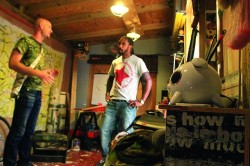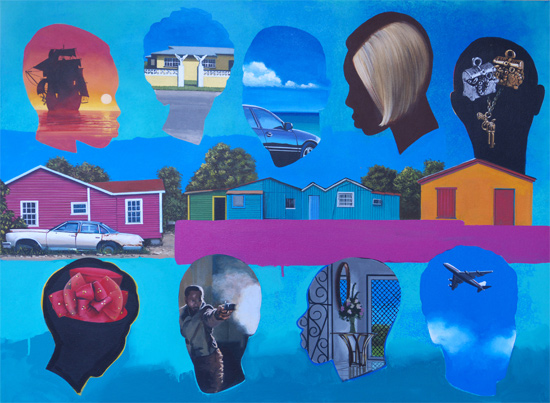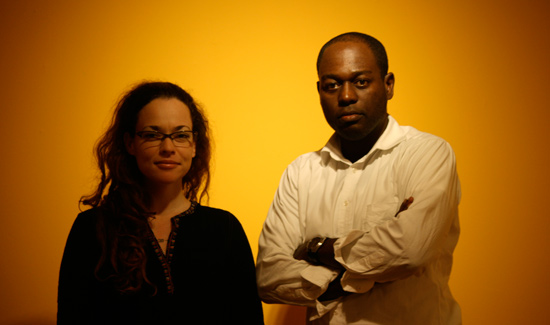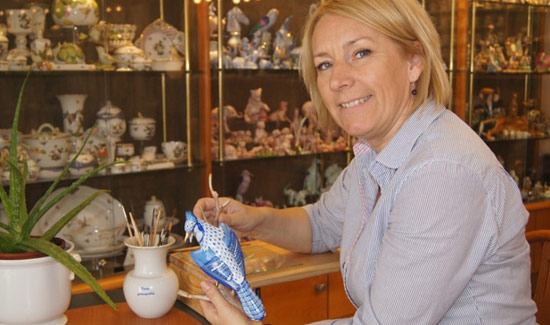
When you view artwork in a gallery, how often do you think about its life? Artwork begins in the mind of its creator, then exists in stages in a studio space that is hardly, if ever, visited by the wider public. Once it reaches a gallery, it is only there for the blink of an eye before continuing its life in domestic spaces and collections.
If you’ve ever been curious about the artist’s process, then sign up for “Outside the Gallery”, an exclusive art tour by Jonathan Murray of Downtown Art Tours. On the morning of June 11th, an intimate gathering of participants will be able to take a bus tour to the private art studios of four local artists — Antonius Roberts, John Cox, John Beadle, and Tyrone Ferguson — to get a rare glimpse into their different processes of creation.
For Jonathan Murray, “Outside the Gallery” is a different pace from his usual Downtown Art Tours experience, which takes its participants on a walking tour through various gallery spaces downtown as well as the “Love My Bahamas” public murals scattered around town.
“I wanted to have tours different from what I would usually do. This tour shows the process of making the work so it gives a larger context of the work,” Murray explains. “For many viewers the process begins and ends at the exhibition, but there’s still another life which takes place. It’s usually only people in the art community who have access to these spaces. So I wanted to give other people the opportunity to have the experience they usually wouldn’t have unless they were involved with the arts community directly.”
When someone views work in a gallery, they’re often viewing work that is deliberately laid out to guide a specific path, story or emotion. Seeing work out of this context, with little editing and in a more personal setting of a domestic studio space, gives new perspective not only to the work itself and the thinking or process of the artist, but also alters further relationships of artwork to these individuals — an awareness extends out now beyond the four walls of the gallery to create an appreciation of that timelessness contained in each piece.
Add to this the fact that these artist present spaces of varying privacy and the opportunity becomes something rather voyeuristic and exciting as the lines between private and public become blurred. It’s something that can be equally liberating and debilitating for the artists involved.
“I appreciate the four walls of a gallery, but I don’t feel they’re necessary. They position work that brings work a level of clarity and also isolation, which can be useful. But I don’t have a problem with works being kind of out of that space in the more public domain or a more domestic situation,” explains John Cox, whose home studio space, “Center John Cox”, off of Eastern Road, will be a stop on the tour.
As viewers may think of his primary space as that in his Popop Studios, it may come as a pleasant surprise to explore this new space with his varying projects that branch from his “I Against I” series. Viewers may also be exposed to the extensive collection of work inside of his house, giving them an awareness of the life of artwork beyond an exhibition and in a different context or relationship with other pieces of a home collection.
“I think that these momentary scenarios of the white cold gallery space, its kind of like the wedding, the wedding is not the marriage; they carry on after that. It gets more interesting that way,” he says. “I think the process, the how, is very important. I feel like its precious and its special but it doesn’t need to be kept it to yourself. It’s worth sharing if we share it the right way, and this seems like sharing in the right way, this tour, with an intimate group. I think there’s something refreshing and equally inspiring about seeing work being done and knowing how it gets done.”
Though this kind of exposure creates an opportunity for viewers to learn more about the private processes of major local artists, the interaction can also become complicated.
For John Beadle, whose studio off of Eastern Road is also a stop on the tour, having people enter his gallery space is an unexpected situation where he feels all need to tread carefully.
“The difference here is that there are none of the things in the formal gallery situation that helps to describe me; the gallery setting is about showcasing the work as an isolated event. The personal, beyond the work, has been edited out to a great extent,” he explains. “In the studio space one might catch glimpses of other things that give greater information beyond the work or works that may or may not relate to any of the work being seen at that time. The audience will form connections where none is intended.”
He admits he is the kind of artist who needs “head space and my physical space free of distraction”, which many creative people may understand. Does a director invite an audience out to their dress rehearsal? Do writers publish their unedited novels? No, though exposing the process — being present backstage, or reading the newly discovered journals and previous drafts by long gone writers — can prove to be an eye-opener and lead to a greater appreciation of their work, as long as the viewer keeps an open mind.
“I think this will add just a little more to their confusion about the artist and their practices — you know the romantic notion,” Beadle points out. “But a far as the work is concerned and its life, it can only endear the participants to any work they may encounter in the future. Experiencing any part of the creative process is very, very stimulating.”
That kind of stimulation is exactly that Jon Murray is aiming for, hoping that instead of having artists create more work to display in the public sphere, they instead open their doors to them. But there’s a sense of responsibility involved on the public’s part; an exchange of some understood and unworded secret that involves an open mind and heart.
“There’s a serious sense of privacy here,” Murray admits. “I do think that its important though. Even through we’re a small and tight community, we’re all still very careful about our creations, and I don’t think that’s a good thing, necessarily. There could be a lot more sharing and opportunity for artists in some cases. But in other cases you need the privacy to create hype, but I think there’s give and take involved.”
When choosing which studio spaces to visit, Murray also wanted to present spaces where he knew artists would have a lot to engage with and spaces where unusual processes may surprise the viewer.
One such space is the studio of Antonius Roberts, who among his various projects will offer viewers a chance to see what he is working on for the next art installation for the upcoming stage of the LIPA, as well as an exclusive surprise for participants that will apply to the theme of the tour.
“I thought about who is producing a lot because I think that’s a challenge we have, that most visual artists will have peaks and lows corresponding to exhibitions,” explains Murray. “So I thought about which artists will have lots of things and at different stages, and these are all people who are constantly working on ideas, different projects. None of them I think actually have just one project they’re doing at any given time, they actually have a really diverse cross-section of projects, which I think for the audience can provide something interesting. So not only may these spaces be exclusive looks but they also provide different elements of processes.”
In choosing the studio space of Tyrone Ferguson, for example, Murray hopes to expose viewers to more of a collaborative art space to show how different artists operate either with themselves or with a team of people. Ferguson’s space is more public than private, as it has been included in the Transforming Spaces tours before. Whereas viewers may have a specific idea of the artist as a reclusive person involved in their own solitude to foster creation, they rarely expect artists to lead a team in the making of their own private work.
“People don’t seem to grip well this role of the artists and how they’re involved in the creation of their work and what their responsibility is to the creation of their work. Like when we talk about Michelangelo, yes he painted the Sistine Chapel, but he had like 18 assistants that helped him the whole time,” Murray points out. “I think that’s often unclear to the wider public and this allows an opportunity for viewers to see that yes, some artists do chose to physically do the work, and others are more managers or conceptual directors.”
Overall the tour promises to spark some great debate within the circle of participating viewers and artists alike as to the function of public and private realms in our small but thriving art scene. Though costs of each ticket may come as a surprise — each one at $100 — participants should know the funds not only provide them with a great and unusual one-time experience bus tour, complete with wine and lively discussion, but also will go towards funding Jon Murray’s educational endeavour this summer.
He’s been accepted into the Arts Marketing and Communications intensive course at the esteemed Sotheby’s Institute of Art in New York City this summer. He’s offering a great service in exchange, and an investment in this course is an investment in our culture, as Murray plans to use this course to expand his Downtown Art Tours company and further promote the culture of The Bahamas to locals and visitors alike.
“The reason I started the company wasn’t just for art tours; art tours are just what I do best. The idea was that this should be a whole bunch of tours about culture and heritage,” he says. “So I’ll slowly introduce other experiences.”
He has big future plans, starting with a downtown tour focusing on traditional Bahamian architecture.
For now, though, those interested in the special eye-opening tour “Outside The Gallery” and to help Jon Murray as he continues to promote Bahamian arts and culture can contact him at contactus@downtownarttours.com or call 431 8964.
Sonia Farmer
The Nassau Guardian



